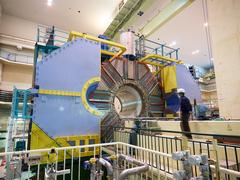URL: https://www.desy.de/news/news_search/index_eng.html
Breadcrumb Navigation
DESY News: First particles turning inside upgraded SuperKEKB accelerator
News
News from the DESY research centre
First particles turning inside upgraded SuperKEKB accelerator
Accelerator experts in Japan started up the completely upgraded particle accelerator SuperKEKB this week. For the first time since its five-year upgrade, electrons and positrons are once again making turns around the three-kilometre-long accelerator ring. This is an important step towards producing particle collisions inside the similarly refurbished detector Belle II, in which DESY and other universities and institutes in Germany are significantly involved. With the help of these collisions, physicists are hoping to find an answer to the question why the universe consists of matter even though equal amounts of matter and antimatter should have been produced in the Big Bang. SuperKEKb is the first new collider to start up after the Large Hadron Collider at CERN in Geneva.
The circulating particles mark an important milestone, yet the project is still at its very beginning. The research programme will not start for another two years. Until a few years ago, the accelerator was called “KEKB” and the detector “Belle“, and together they provided some important fundamental insights into the structure of matter. That success led to the Nobel Prize in Physics being awarded to the Japanese theoretical physicists Makoto Kobayashi and Toshihide Maskawa in 2008. The upgraded SuperKEKB is expected to produce 50 times more collision data than its predecessor. This higher luminosity, which is a measure of the number of collisions, will be achieved using particularly powerful focussing magnets and other new components inside the accelerator.Having more collisions also makes greater demands on the detector, however, which now faces the task of sifting through a much larger tangle of particle collisions and filtering out and recording the most exciting of these. To do this, the Belle II researchers are developing new detector components, which will be arranged directly around the interaction region and which will be able to precisely record the tracks, decay products and other properties of the particles created during the collisions. One such component is the ultrasensitive vertex detector, part of which is being built by German groups.
The researchers are particularly interested in identifying B mesons – particles containing at least one b quark or b antiquark. Pairs of B mesons will be created in large numbers by SuperKEKB. These could shed light on the imbalance between matter and antimatter in the universe. Through its high collision rates, Belle II complements the research being conducted in the LHCb experiment at the Large Hadron Collider in CERN, because it is far better at detecting and examining certain rare processes.
Before the highly sensitive vertex detector can be exposed to particle collisions, though, the scientists first want to understand exactly what the tangle of collisions and decay processes looks like, so that they can “adjust” the accelerator correctly right from the start. To this end, they are building a sort of high-tech dummy detector, which will initially be installed instead of the vertex detector, so as to be able to study the background in great detail. With reference to the fairy tale of Beauty (Belle) and the Beast, it has been christened BEAST II (Beam Exorcism for A STable Belle II). BEAST II is to start recording data in the autumn of 2017.
DESY is one of eleven German and 98 international institutes from 23 nations that are jointly developing and building the Belle II detector, and that will later analyse the data it produces. Some 20 research scientists at DESY are making sure that BEAST II and prototypes of the final vertex detector are tested under realistic conditions in DESY’s test beam, and can later be safely integrated in the Belle II detector. Beyond this, they share responsibility for the complex cooling system and must ensure that all the components of the detector are perfectly aligned and properly calibrated, and that the magnetic field is measured accurately. Furthermore, Belle II will produce huge quantities of data, which will have to be stored, reconstructed and analysed. DESY is in charge of a significant proportion of the storage and computing capacity.
Press release of Research Centre KEK




